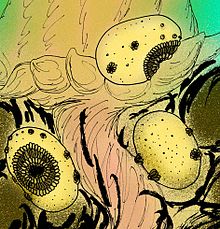Saccorhytus
|
Saccorhytus Temporal range: Fortunian, 540 Ma |
|
|---|---|
 |
|
| Artist's reconstruction of Saccorhytus coronarius. | |
| Scientific classification | |
| Kingdom: | Animalia |
| Superphylum: | Deuterostomia |
| (unranked): |
Saccorhytida Han, Shu, Ou and Conway Morris, 2017 |
| Family: |
Saccorhytidae Han, Shu, Ou and Conway Morris, 2017 |
| Genus: | Saccorhytus |
| Species: | S. coronarius |
| Binomial name | |
|
Saccorhytus coronarius Han, Shu, Ou and Conway Morris, 2017 |
|
Saccorhytus (from Latin saccus "bag" and Ancient Greek ῥύτις rhytis "wrinkle") is an extinct genus of animal belonging to the superphylum Deuterostomia, which is represented by a single species, Saccorhytus coronarius (from Latin attributive coronarius "[of a] crown"). Having lived approximately 540 million years ago in the Fortunian stage of the Cambrian Period, it is the oldest known confirmed species of this superphylum.
Fossils of the species were first discovered in the Shaanxi province of China by a team of scientists from the UK, China and Germany, and the findings were first published in January 2017.
Saccorhytus was only about a millimetre (1.3 mm) in size and is characterised by its globular or hemispherical body with a prominent mouth. Its body was covered by a thick but flexible cuticle. It had four nodulate rugae above its mouth. Around its body are eight openings in the form of truncated cones with radial folds, termed "body cones." Two sets of small circular pores also occur on the body; one set is widely separated and runs parallel to the body cones, while the other set is more dorsal and consists of sub-linear arrays. The latter set of pores may have housed setae, which may have played a haptic role, including temporary attachment, while the former set may have had a sensory function, though they could have alternatively released internal contents like adhesive mucus or gametes. In the mid-region of its body, spines protrude anteriorly. There is no evident anus, which means that the animal must have consumed its food and excreted it from the same orifice, though the body cones may have served this function as well in addition to expelling water. However, the strong folding found in the fossils makes this conclusion tentative, with Simon Conway Morris, one of the scientists involved in its discovery, admitting the possibility that the team simply has not spotted it.
Saccorhytus is classified as a deuterostome due to its possession of body openings in the form of its body cones, which appear similar to apparently equivalent structures in vetulicolians and vetulocystids, and thus was thought to be closely related to those two clades by Han et al. Below is a simplified phylogenetic tree based on that constructed by Han et al.
...
Wikipedia
